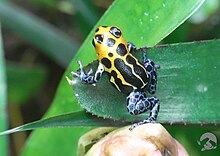Ranitomeya imitator
| Ranitomeya imitator | ||||||||||||
|---|---|---|---|---|---|---|---|---|---|---|---|---|

Ranitomeya imitator "Chazuta" |
||||||||||||
| Systematics | ||||||||||||
|
||||||||||||
| Scientific name | ||||||||||||
| Ranitomeya imitator | ||||||||||||
| Schulte , 1986 |
Ranitomeya imitator is a variably colored frog from the family of Dendrobatidae , which are trivially referred to as poison dart frogs or poison dart frogs . The name imitator is based on the mimicry phenomenon of the imitation of a species occurring in the same habitat. Different color morphs of R. imitator imitatespecies such as R. variabilis , R. fantastica or R. summersi, depending on the area of distribution.
features
With a body length of about 20 mm, R. imitator is an average-sized member of the genus Ranitomeya . The basic color of all known populations is black. The colored patterns on the back range from green to yellow to orange. The shape of the color samples ranges from symmetrical longitudinal lines to net-like, asymmetrical drawings. The legs can be a continuation of the body pattern in terms of color and pattern, but are partially also completely different, both in color and in terms of the type of pattern. The belly is mostly drawn roughly like a net or dotted with a relatively small amount of black. The males have a distinctive call of short whistling tones.
distribution and habitat
The known distribution area of R. imitator is the Amazon rainforest in the Loreto region and the San Martín region in Peru . Primary and secondary hot, humid lowland rainforest as well as moist premontane forest are inhabited up to 1000m above sea level.
Way of life
R. imitator often lives monogamous and the couples practice sophisticated brood care. The eggs are laid in sheltered places. Usually 2 eggs are laid. When the tadpoles are ready to hatch , the male transports them individually to suitable water points, usually the leaf axils of bromeliads . The male encourages the female to lay unfertilized eggs in the watering holes with their own tadpoles. These eggs serve as food for the burbot. The tadpoles are facultative esophageal and do not depend on the supply of eggs. It takes about 80 days to develop into a frog. R. imitator feeds mainly on small insects and mites.
literature
- Lötters, Jungfer, Henkel, Sschmidt: Poison dart frogs - biology, husbandry, species . Edition Chimaira, Frankfurt am Main 2007
- Evan Twomey, Victor Morales & Kyle Summers: A Key Ecological Trait Drove the Evolution of Biparental Care and Monogamy in an Amphibian. The American Naturalist, April 2010
- Jason Lee Brown, Evan Twomey, Victor Morales & Kyle Summers: Phytotelm size in relation to parental care and mating strategies in two species of Peruvian poison frogs. Behavior, 145, pp. 1139-1165, 2008
- Jason Lee Brown, Evan Twomey, Adolfo Amézquita, Moisés Barbosa De Souza, Jana-Lee P. Caldwell, Stefan Lötters, Rudolf von May, Paulo Roberto Melo-Sampaio, Daniel Mejía-Varga, Pedro Perez-Peña, Mark Pepper, Erik H Poelman, Manuel Sanchez Rodriguez & Kyle Summers: A taxonomic revision of the neotropical poison frog genus Ranitomeya (Amphibia: Dendrobatidae). In: Zootaxa, 3083, 2011
- Rainer Schulte: Poison dart frogs - species part Peru. Nikola Verlag, Stuttgart 1999
Web links
G. Schmied, dendrobatidae.ch [1] Status: January 2012
- Ranitomeya imitator inthe IUCN Red List of Threatened Species 2013.1. Posted by: Javier Icochea, Ariadne Angulo, Karl-Heinz Jungfer, 2004. Accessed November 19, 2013.

